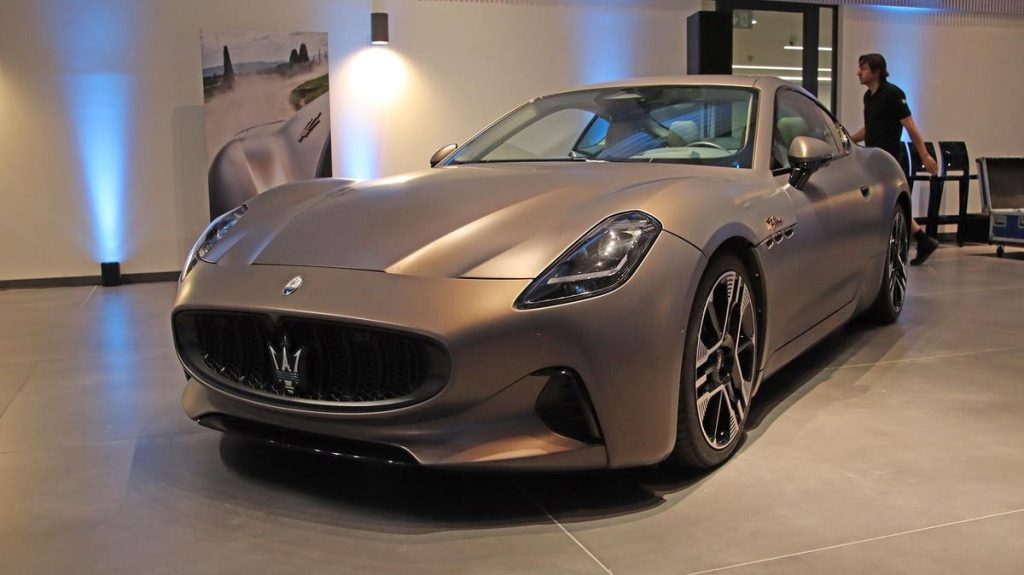Maserati is the kind of legendary car brand that will always face resistance when it makes major design changes. If the move from V8 to V6 wasn’t already a wrench, the company is hoping that its electric GranTurismo Folgore will have what it takes to convince customers to choose an EV. I talked to Maserati’s Chief Vehicle Engineer Sandro Bernardini and Global Product Manager Massimo Capaldi about the design philosophy behind the Folgore and what it means for the automaker’s future.
The Maserati brand has been in existence for over a century, with a strong pedigree in racing in its earlier years. But while Maserati has been synonymous with speed throughout its history, its grand tourers have been some of its most compelling vehicles. The original GranTurismo finished production in 2019 after 12 years, culminating a line of GT cars stretching back decades. Now it’s back, but this time with an electric option alongside a traditional internal combustion engine (ICE) version (but running a V6, not a V8).
At the rather bedraggled Goodwood Festival of Speed, Sandro Bernadini explained to me how the Folgore would live up to its GranTurismo name. First of all, this is a powerful car. It has three 300kW (402hp) motors – one on the front and two on the rear – with silicon carbide inverters derived from the Maserati Formula E car and potent torque vectoring sending power to each wheel individually as required. However, the battery can’t deliver the 1,200+hp combined motor power, so the maximum available at any time is 560kW (761hp), with 1,350Nm of torque. But that is still enough to propel the car to 62mph in just 2.7 seconds and onwards to a top speed of 202mph.
The 92.5kWh (83kWh usable) battery is enough for 280 miles of WLTP range, which is well behind a Tesla Model S. But the 800V subsystem can deliver DC charging at up to 270kW, so you can replenish from 20 to 80% in just 18 minutes, and adding 62 miles takes just 5 minutes. There’s 22kW AC charging too, and up to 400kW of regeneration to put power back in the batteries when you brake. This will also be technology derived from Maserati’s Formula E vehicle.
These figures compare favorably with the GranTurismo Trofeo with its V6 Nettuno internal combustion engine. The latter only has 542hp and 649Nm of torque, meaning it can reach 62mph in 3.5 seconds with a top speed of 199mph. The Trofeo does have a longer range of over 400 miles and can be refueled more quickly. It’s also 495kg lighter (1,795kg versus 2,260kg), so will be a more agile drive. But neither car is exactly light. This is a grand tourer, after all, not a track day special.
Maserati hasn’t chosen to use a BEV-only platform for the Folgore, despite parent company Stellantis having a slew of pure-electric options waiting in the wings. In fact, it shares a platform with the Trofeo, which might make you wonder if it’s a compromised electric car. It doesn’t use the typical “skateboard” design for starters, where the batteries sit in a flat block below the interior cabin floor. But Bernadini argues that its approach, with the batteries down the middle of the car (where the transmission tube would be in the Trofeo) gathers battery mass closer to the roll axes, improving vehicle agility during a change of direction. Early test drives have praised the effectiveness of this approach, despite the overall weight.
The Folgore is meant to be part of a renaissance for Maserati, building on the positive reception of the thrilling and well received MC20 mid-engine sportscar. “With the MC20, we completely rebuilt the brand,” says Massimo Capaldi. “Starting from there, we made a clear decision to go electric.” He knew from the beginning that pitching an electric GranTurismo to Maserati’s existing customer would be challenging. “One of the challenges was to convince our own customers that are doubtful about electrification.” Maserati’s approach to this was to produce a halo vehicle to represent what electrification stands for with the brand. “We wanted to have the ICE version and the electric version at the dealership, one next to the other, to spread doubt with the customer. Should they buy one or the other? We wanted to make the GranTurismo Folgore and future models the best in terms of electric capabilities. For example, we did not limit the maximum speed and went all in with acceleration.”
“We also wanted to make it unique,” continues Capaldi. “The challenge was creating this doubt. So we asked the engineering and the design teams to make on one side a car that looks exactly the same and drives the same, but on the other side delivers something unique for the Folgore with the suspension settings, the balance and the three motors. The reaction when driving the Folgore, feeling all the power of an electric car with drivability and fun, means nobody will regret choosing it over the Trofeo.”
Maserati has already had to convince its traditional owners that the switch from V8 to V6 was worth making. The compay also, obviously, wants to gain new customers. But Capaldi doesn’t necessarily want either to choose the Folgore over the ICE Trofeo. “But our aim is at least to make them try,” says Capaldi. “That’s the real challenge. Normally, a sports car means the sound of a V8, V10 or V12 engine. But once you try the Folgore, it’s very difficult to come back.”
Maserati has future plans for an electric MC20, and also wants to create an electric roadster. But for now, the GranTurismo Folgore is the company’s flagship EV. With the level of performance, luxury and looks it provides, it’s a classic GT with the potential to drive long distances at speed, which just happens to be an EV. It could be what lovers of Italian grand tourers need to make the switch to electric.
Read the full article here










